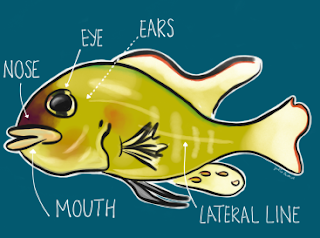I’ve got sickness on my mind…

Hey guys! It’s Burt again back with more fun science for you to explore. Last time I told you a little about smell and how it helps me communicate with Toni and other fish in my environment. We saw how the delivery and reception of chemical odorants dissolved in the water are important in mediating social interactions. Just as it’s important for me to communicate with Toni and other fish, it’s also important that systems throughout my body are able to communicate between each other, particularly the immune and nervous systems. Just like you, my brain allows me to take in information from my environment, process it, and produce an appropriate response. Although this process takes a lot of energy, I’m able to do this fairly well, which is great because I need to perform a variety of behaviors like finding food, dancing for the ladies, defending my territory, and protecting myself from predators. But recently, I’ve been more concerned with how well I’ll be able to perform these basic func




